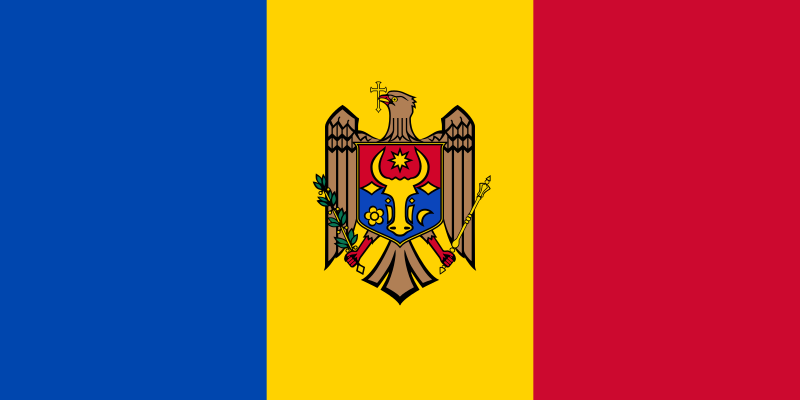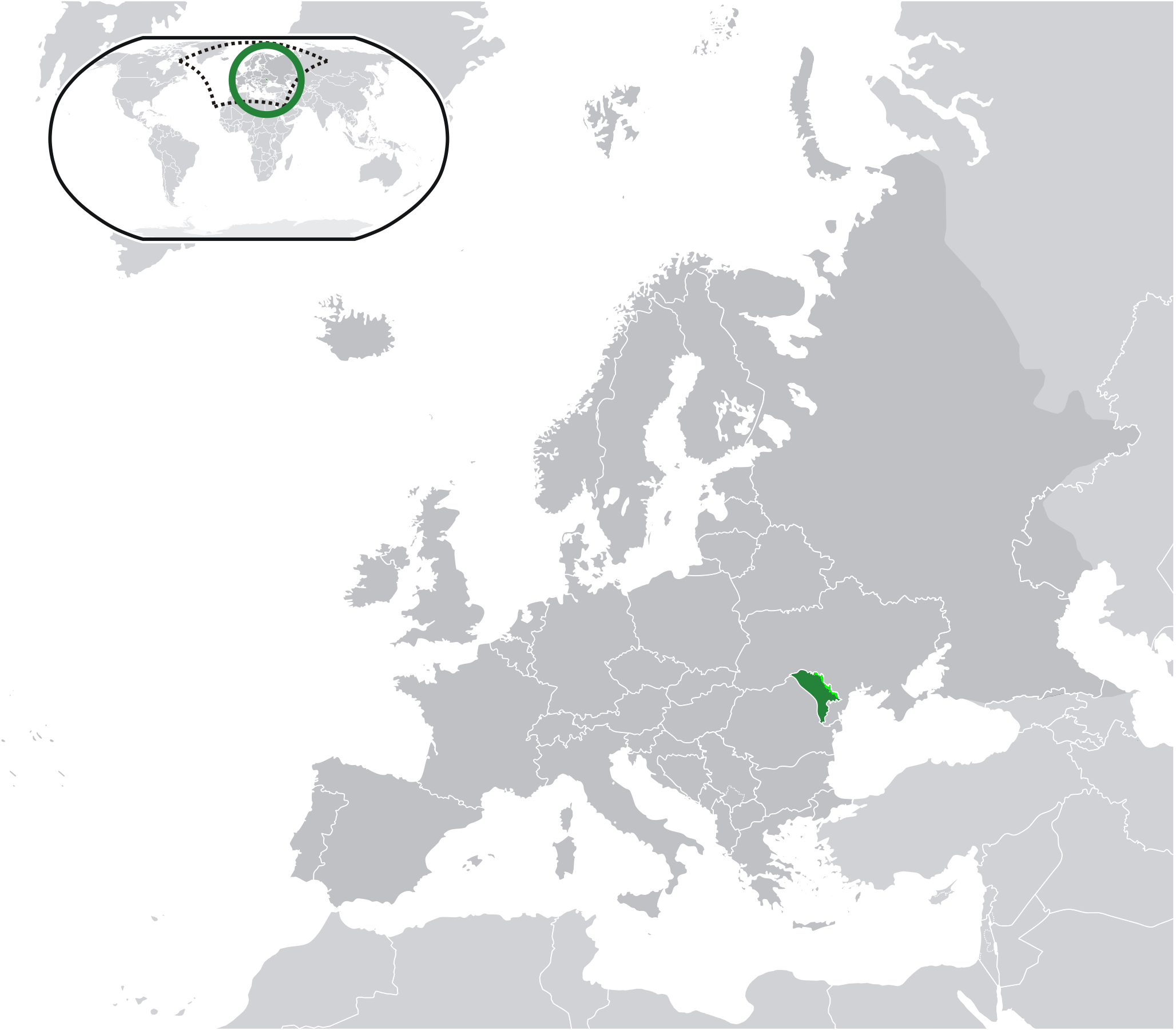More languages
More actions
(Updated Infobox country template parameter) |
No edit summary Tag: Visual edit |
||
| Line 1: | Line 1: | ||
{{Infobox country|name=Republic of Moldova|native_name=Republica Moldova|population_estimate=2,597,100|population_estimate_year=2021|area_km2=33,843.5|mode_of_production=Capitalism|government_type=Unitary parliamentary republic|leader_title1=President|leader_title2=Prime Minister|leader_name1=Maia Sandu|leader_name2=Natalia Gavrilița|official_languages=Romanian|image_flag=Moldova flag.png|capital=Chișinău|largest_city=Chișinău}} | {{Infobox country|name=Republic of Moldova|native_name=Republica Moldova|population_estimate=2,597,100|population_estimate_year=2021|area_km2=33,843.5|mode_of_production=Capitalism|government_type=Unitary parliamentary republic|leader_title1=President|leader_title2=Prime Minister|leader_name1=Maia Sandu|leader_name2=Natalia Gavrilița|image_map=Moldova map.png|map_width=290|map_caption=Transnistria is in light green.|official_languages=Romanian|image_flag=Moldova flag.png|capital=Chișinău|largest_city=Chișinău}} | ||
'''Moldova''', officially the '''Republic of Moldova''', is a country in [[Eastern Europe]]. | '''Moldova''', officially the '''Republic of Moldova''', is a country in [[Eastern Europe]]. | ||
| Line 5: | Line 5: | ||
== History == | == History == | ||
=== Soviet | === Soviet era === | ||
Moldova was | Moldova was liberated by the [[Union of Soviet Socialist Republics|Soviet Union]] in 1940 and became the [[Moldavian Soviet Socialist Republic|Moldavian SSR]]. It declared independence on August 27, 1991, and it became independent after the [[Overthrow of the Soviet Union|dissolution of the USSR]]. | ||
=== Capitalist | === Capitalist era === | ||
In 1990, the regions of [[Gagauzia]] and [[Transnistria]] | In 1990, the regions of [[Gagauzia]] and [[Transnistria]] declared independence from Moldova. Moldova fought to regain control of Transnistria from 1990 to 1992 but was defeated because Transnistria had [[Russian Federation|Russian]] support.<ref>{{Citation|author=William Crowther|year=1997|title=Moldova: caught between nation and empire|chapter=|section=|page=322|quote=|pdf=|city=|publisher=Cambridge University Press|isbn=|doi=|lg=|mia=|title-url=|chapter-url=|trans-title=|trans-lang=}}</ref> Gagauzia was reintegrated into Moldova in 1994.<ref>{{Citation|author=Klaus Neukirch|year=2002|title=Autonomy and Conflict Transformation: The Case of the Gagauz Territorial Autonomy in the Republic of Moldova|chapter=|section=|page=105–123|quote=|pdf=|city=Budapest|publisher=Minority Governance in Europe|isbn=|doi=|lg=|mia=|title-url=https://web.archive.org/web/20190220195710/http://pdfs.semanticscholar.org/2d8e/6d05bec3d17180c10434a650c22d4bfb045d.pdf|chapter-url=|trans-title=|trans-lang=}}</ref> Since the return of capitalism, there has been widespread poverty in Moldova, and the poverty rate increased from 4% in the late 1980s to 66% in 1993.<ref>{{Citation|author=Branko Milanovic|year=1998|title=Income, Inequality, and Poverty during the Transition from Planned to Market Economy|chapter=Poverty|section=By How Much Has Poverty Increased?|page=68|pdf=https://web.archive.org/web/20210314180055/https://www.gc.cuny.edu/CUNY_GC/media/CUNY-Graduate-Center/PDF/Centers/LIS/Milanovic/papers/Income_ineq_poverty_book.pdf|city=Washington, D.C.|publisher=World Bank|isbn=082133994X}}</ref> In 2013, 42% of Moldovans said life was better under socialism compared to only 26% that said it was better now.<ref>{{News citation|journalist=Neli Espova, Julie Ray|date=2013-12-19|title=Former Soviet Countries See More Harm From Breakup|url=https://news.gallup.com/poll/166538/former-soviet-countries-harm-breakup.aspx|newspaper=Gallup|archive-url=|archive-date=|retrieved=2022-01-02}}</ref> | ||
== References == | |||
[[Category:Countries]] | [[Category:Countries]] | ||
Revision as of 19:29, 8 August 2022
Moldova, officially the Republic of Moldova, is a country in Eastern Europe.
History
Soviet era
Moldova was liberated by the Soviet Union in 1940 and became the Moldavian SSR. It declared independence on August 27, 1991, and it became independent after the dissolution of the USSR.
Capitalist era
In 1990, the regions of Gagauzia and Transnistria declared independence from Moldova. Moldova fought to regain control of Transnistria from 1990 to 1992 but was defeated because Transnistria had Russian support.[1] Gagauzia was reintegrated into Moldova in 1994.[2] Since the return of capitalism, there has been widespread poverty in Moldova, and the poverty rate increased from 4% in the late 1980s to 66% in 1993.[3] In 2013, 42% of Moldovans said life was better under socialism compared to only 26% that said it was better now.[4]
References
- ↑ William Crowther (1997). Moldova: caught between nation and empire (p. 322). Cambridge University Press.
- ↑ Klaus Neukirch (2002). Autonomy and Conflict Transformation: The Case of the Gagauz Territorial Autonomy in the Republic of Moldova (pp. 105–123). Budapest: Minority Governance in Europe.
- ↑ Branko Milanovic (1998). Income, Inequality, and Poverty during the Transition from Planned to Market Economy: 'Poverty; By How Much Has Poverty Increased?' (p. 68). [PDF] Washington, D.C.: World Bank. ISBN 082133994X
- ↑ Neli Espova, Julie Ray (2013-12-19). "Former Soviet Countries See More Harm From Breakup" Gallup. Retrieved 2022-01-02.


